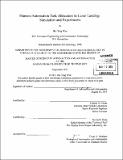Human-automation task allocation in lunar landing: simulation and experiments
Author(s)
Wen, Hui Ying
DownloadFull printable version (19.23Mb)
Other Contributors
Massachusetts Institute of Technology. Department of Aeronautics and Astronautics.
Advisor
Charles M. Oman and Kevin R. Duda.
Terms of use
Metadata
Show full item recordAbstract
Task allocation, or how tasks are assigned to the human operator(s) versus to automation, is an important aspect of designing a complex vehicle or system for use in human space exploration. The performance implications of alternative task allocations between human and automation can be simulated, allowing high-level analysis of a large task allocation design space. Human subject experiments can then be conducted to uncover human behaviors not modeled in simulation but need to be considered in making the task allocation decision. These methods were applied here to the case scenario of lunar landing with a single human pilot. A task analysis was performed on a hypothetical generic lunar landing mission, focusing on decisions and actions that could be assigned to the pilot or to automation during the braking, approach, and touchdown phases. Models of human and automation task completion behavior were implemented within a closed-loop pilot-vehicle simulation for three subtasks within the landing point designation (LPD) and final approach tasks, creating a simulation framework tailored for the analysis of a task allocation design space. Results from 160 simulation runs showed that system performance, measured by fuel usage and landing accuracy, was predicted to be optimized if the human performs decision making tasks, and manual tasks such as flying the vehicle are automated. Variability in fuel use can be attributed to human performance of the flying task. Variability in landing accuracy appears to result from human performance of the LPD and flying tasks. Next, a human subject experiment (11 subjects, 68 trials per subject) was conducted to study subjects' risk-taking strategy in designating the landing point. Results showed that subjects designated landing points that compensated for estimated touchdown dispersions and system-level knowledge of the probabilities of manual versus automated flight. Also, subjects made more complete LPD compensations when estimating touchdown dispersion from graphical plots rather than from memories of previous simulated landings. The way in which dispersion information is presented affected the consistency with which subjects adhered to a risk level in making landing point selections. These effects could then be incorporated in future human performance models and task allocation simulations.
Description
Thesis: S.M., Massachusetts Institute of Technology, Department of Aeronautics and Astronautics, 2011. Cataloged from PDF version of thesis. Includes bibliographical references (pages 59-62).
Date issued
2011Department
Massachusetts Institute of Technology. Department of Aeronautics and AstronauticsPublisher
Massachusetts Institute of Technology
Keywords
Aeronautics and Astronautics.